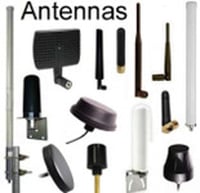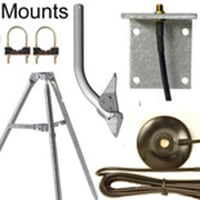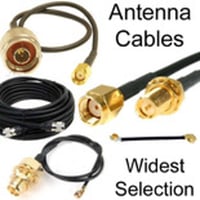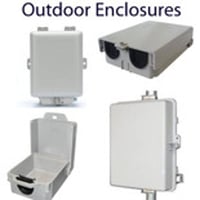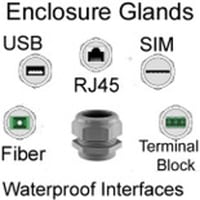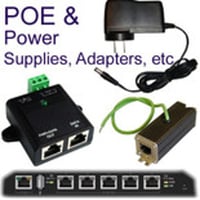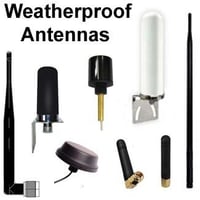Ethernet Cables & Fiber
Ethernet Cables & Fiber:
Differences among CAT5e, CAT6, CAT6A, CAT7, CAT8 Ethernet cable
Ethernet cables physically connect local area networks via eight internally twisted and shielded wires. The wires come in either solid or stranded configurations. Solid wires deliver better performance but are more fragile and prone to break.
Understanding the categories of Ethernet cabling is crucial to selecting the right one for your networking needs.
Twisted-pair Ethernet cables have progressively improved performance over consecutive generations. Tighter winding, complex sheathing, and shielding have resulted in the advancement of Ethernet cable categories. Here is a summary of the different categories of Ethernet cables.
CAT 5e
- CAT5e is Enhanced CAT 5 and is an improvement to the standard CAT 5. CAT 5e is a Class D cable operating at a data transmission bandwidth frequency of up to 100 MHz and a 1000Mbps data transfer rate with a maximum range of 100 meters. CAT 5e can ideally be used for 1Gbit applications.
- CAT 5e has completely replaced its predecessor, CAT 5. It is preferred in home and office networks with moderate data transfers between 10-100 meters due to its flexibility, low cost, ease of crimping and Gigabit Ethernet capability.
CAT 6
- CAT 6 is a Class E cable. Supports data transfer rates of up to 10Gbps at a peak bandwidth frequency of 250 MHz. CAT 6 is certified for a maximum range of 100 meters, though due to crosstalk at 10Gbps it is reliably used for a maximum of 55 meters’ transmissions.
- CAT 6 is more tightly wound than CAT 5e at more than 2 twists/cm, featuring a tougher outer sheath and central pair separator spine to reduce Alien and near crosstalk, and increase rigidity.
CAT 6 lies in a grey area between the cost-effectiveness of CAT 5e at Gigabit speed and the significant performance improvement of CAT 6A.
CAT 6A
- The A stands for “Augmented.” CAT 6A cables support 10Gbps data transfers at 500 MHz - twice the frequency of CAT 6 and supports 10Gbps speeds to 100 meters. The cable has a thicker sheath then CAT 6, reducing crosstalk and increasing SNR at high data speeds. The CAT 6A is a Class Ea cable owing to the thick sheath and even stiffer pair separator spine reducing its flexibility.
- Due to its low flexibility and tough sheath, CAT 6A cables are generally used for industrial applications, outdoor and large-scale networks requiring high data transfers over long distances.
CAT 7
- CAT 7 is a stiff Class F cable, with separate twisted pair shielding and additional overall outer shielding beneath a tough outer Sheath. Tests have shown that CAT 7 can transmit at a 600 MHz bandwidth frequency, 10Gbps to 100 meters, 40Gbps to 50 meters and 100Gbps to 15 meters.
- Shielding on the CAT 7 cable needs to be grounded especially at high transfer speeds. It requires GigaGate45 connectors, and modern infrastructure to realize the full speed. CAT 7A is also available, sharing most features with CAT 7, but able to transmit at 1 GHz bandwidth frequency.
CAT 7 is almost exclusively used in data centers and lager high-throughput network.
CAT 8
- CAT 8 is a heavily shielded Class II cable that is yet to hit mainstream after extensive testing and standardization. CAT 8 can support bandwidths of up to 2 GHz, and manage a data transfer rate of 25Gbps and 40Gbps on a maximum cable length of 30 meters.
- CAT 8 is intended for use in high-performance server rooms and data centers.
Ethernet Cables for Local Area Networks
Ethernet cables are a type of networking cable that are used to connect electronic devices. They are widely used to create wired networks of varying sizes, specifications, and complexity. When they are terminated with their complementary Ethernet connector and Ethernet ports. Ethernet cables are capable of supporting data transfer of varying speed and throughput. Computers and other hardwired networked devices use Ethernet cables to securely share files and communicate efficiently. They are one of the early building blocks or media specified in the Physical Layer (PHY) of many well-known network protocols as well as a key component in providing internet connectivity.
Quality RoHS compatible Ethernet cables and connectors. Our extensive range of Ethernet cables, connectors, and other accessories are manufactured to the highest standards for consistent, reliable performance. All materials and fabrication techniques used are fully compliant with the following legislation:
- The Restriction of Hazardous Substances (RoHS) Directive
- The Conflict Minerals Regulation
- Section 1502 of the Dodd-Frank Act
What is Ethernet?
Ethernet is a wired networking technology that is used to devise and build a range of local area networks (LANs) and wide-area networks (WANs). It is also capable of supporting metropolitan area networking (MAN), amenity-like expansive networking that connects and serves computers in large numbers and on a scale equivalent to a geographic metropolitan area. It is used in almost every sector of the industry as well as domestic and consumer computing. It also integrates well with WiFi as it is capable of the internetworking necessary for supporting the Internet Protocol.
Ethernet provides physical-space connectivity between computers and devices. The networks created can support a high number of nodes securely and over long distances. It was first standardized in the 1980s with the release of the 802.3 protocol by the Institute of Electrical and Electronics Engineers (IEEE). Since its introduction, it has been further revised and refined with an increase in bit rates, security, and a broadening of its applications while remaining largely backward compatible. Contemporary bit rates can exceed 400 Gbit per second. The standardization of Ethernet has also defined the physical space with all compatible hardware carrying the same standardized ports.
How does Ethernet work?
Ethernet data transfer works by breaking down the data into smaller units known as frames. Each frame carries identifying addresses for the data source and destination. The frames also have an error-checking component that can eliminate damaged frames and trigger their re-transmission.
Ethernet structure and functionality span Layers 1 and 2 of the seven-layer Open Systems Interconnection model (OSI model) for telecommunication and computing systems. This means that it is concerned with the transfer of data between participant nodes in a network via its physical layer which includes Ethernet cables.
Every piece of Ethernet hardware and components has a unique identifier (assigned by the manufacturer) which serves to identify them and be used as a network address. This burned-in address, known as a Media Access Control (MAC) address consists of 6 sets of hexadecimal digits usually separated by hyphens.
The MAC address is used to transfer data frames between nodes correctly. The MAC sublayer oversees which address is allowed to see the transferred frames using collision avoidance protocols.
Ethernet cables are twisted-pair cables
Ethernet was initially developed using coaxial cables rather than the recognizable twisted pair cable that is now in widespread use. 10Base5 Ethernet or thicknet was expensive and difficult to install and maintain, often due to the inflexibility of the coax used.
Contemporary Ethernet cable uses twisted pair cabling. This cable type was invented by Alexander Graham Bell and is made up of paired conducting wires that are twisted together to reduce electromagnetic leakage, noise, and cross-talk.
A twisted-pair Ethernet cable consists of 8 wires that are color-coded and arranged in 4 twisted-pairs. Their color and arrangement are important for terminating Ethernet cables with 8-position modular connectors, like the RJ45 connector.
Twisted pairs are used to create balanced lines which are transmission lines made up of two conductors of the same type and impedance. Because of their proximity, the paired wires will be subjected to the same type and level of EM interference as signals pass along them from the source and will be far easier to cancel out at the receiving end (common mode rejection). Balanced circuits that use these lines are efficient at rejecting electromagnetic interference and are capable of faster and more precise data transfer. If the pairing fails or the system is unbalanced in any way, common-mode rejection fails and the system becomes vulnerable to interference.
The wires may be shielded twisted pair (STP) or unshielded twisted pair (UTP). Shielded or screened wires have foil or braided shielding that is conductive and adds additional protection against electromagnetic interference. The choice of cable may be specified by a networking protocol to achieve specific speeds and performance or selected according to the level of shielding an application requires. The shielding of the cable contributes to its categorization as outlined for each cable type below. The key shielding types are:
- Individual shield (U/FTP)
These twisted pairs or quads have individual aluminum foil shielding. They are also known as “shielded twisted pairs” or “pair in metal foil.” They are effective in preventing leakage of electromagnetic energy and crosstalk.
- Overall shield (F/UTP, S/UTP, and SF/UTP)
This type of shielding also known as shielded twisted pair, foiled twisted pair, or screened twisted pair, covers all of the unshielded pairs within an Ethernet cable with foil, braided shield, or a combination of both.
- Individual and overall shield (F/FTP, S/FTP, and SF/FTP)
With this type of twisted pair cable, there is not only foiled shielding of individual wires within the pairs, but also an overall outer foil or braided shield. It is also known as screened foiled twisted pair, or fully shielded twisted pair. This type of Ethernet twisted pair cable is highly insulated against electromagnetic interference.
- The twist rate of twisted pairs
Twisted pairs have a specified pitch or rate of twisting, measured in twists per meter. This helps to determine the arrangement of the pairs within an Ethernet cable. The pairs that make up a cable must have different twist rates to preserve the benefits of twisting. Adjacent twisted pairs with a like pitch are avoided.
- The twisted pairs within an Ethernet cable are color-coded
A color-coding system is used to identify the individual conducting wires that make up an Ethernet cable. The insulating plastic jacket that surrounds the wires carries the colors, which also guide the wiring of these cables following various standards and specifications.
There are up to 25 different color combinations. Each twisted pair is made up of a major color and minor color which are selected from two different groups. The major colors include white, red, black, yellow, and violet and the secondary colors include blue, orange, green, brown, and slate. The major wire carries a solid block color, and the minor wire in the pair is white with colored stripes or rings.
Types of Ethernet cables
There are 8 types of Ethernet cables with the earlier Ethernet cable types being used for telephone wiring, ISDN, and token ring. The most widely used types of Ethernet cables are Category 5 and 6 cables and their variants which we describe below.
[A] Category 5 Ethernet cable
Cat5 Ethernet cable is a type of twisted pair cable. It is designed to perform at a maximum frequency of 100 MHz. Its most common variant, Category 5e (Cat 5e) can support higher frequencies and is used in computer networking, telecommunications, and video applications. It is specified in the following standards:
- ISO/IEC 11801 is an international standard that is concerned with telecommunication cabling systems, including those used for data transfer. It was initially devised to support networks with up to 50,000 users or nodes across a single building or complex of buildings.
- EN50173 also deals with generic cabling systems, with specifications for category 5 components including cables used in backbone cabling sub-systems.
Category 5 cable is used in key applications such as 10 Base-T, 100 Base-T, FDDI, and ATM.
Category 5 cable physical specifications
- Category 5 cable is available as horizontal patch cable.
- It consists of 4 twisted pairs that are shielded.
- The center conductor in each wire is AWG 26 and made from 7 strands of bare copper.
- The diameter of each conducting wire is 0.48 millimeters (0.018 inches).
- The conductor is insulated by foam skin polyethylene (PE) jacketing with an overall diameter of 0.95 millimeters (0.037 inches) for each wire.
- Cat5 cable also carries a drain wire that works with the cable shielding for effective grounding. This drain wire is made from tinned copper.
- The twisted pairs are shielded with Mylar (aluminum polyester foil). The outer jacket material is flame retardant PVC or Low Smoke Zero Halogen and the cable has an overall diameter of 5.2 millimeters (0.20 inches).
CAT5 FTP cable weighs 27 kilograms per kilometer. Its operating temperature range is -20 to +60 degrees Celsius (-4 to 140 degrees Fahrenheit). It has a minimum bend radius for installation is 40mm (1.57 inches).
The color-coding of the four twisted pairs in Category 5 Ethernet cable is as follows:
- Pair 1 Blue / Striped Blue
- Pair 2 Green / Striped Green
- Pair 3 Orange / Striped Orange
- Pair 4 Brown / Striped Brown
The pitch of each twisted pair is as follows:
- The Blue pair has 72 turns per meter.
- The Green pair has 65 turns per meter.
- The Orange pair has 56 turns per meter.
- The Brown pair has 52 turns per meter.
Category 5 cable electrical specifications
- Category 5 Ethernet cable is rated for frequencies up to 100 MHz.
- It is known for its high signal to noise ratio (SNR), due to the use of balanced lines.
- Its impedance is 100 Ohms +/- 15 Ohms.
- Its nominal mutual capacitance at 1 kHz is 50 nF/km.
- The velocity of propagation of category 5 cable is between 68 and 75 percent.
- At 100 MHz, the attenuation of Cat5 cable is 3.3 dB/10m.
[B] Category 5e Ethernet cable
Category 5e is an enhanced version of the Category 5 Ethernet cable. It was developed by the Telecommunications Industry Association (TIA) to operate at a higher frequency with reduced noise and signal interference. The changes make Cat5e cable palpable of data transfer speeds of up to 350 Mbit per second over a 100 meter (328 feet) distance and improve its suitability for Gigabit Ethernet. Cat5e patch cable is interchangeable with Cat5 Ethernet cable in installations.
[C] Category 6 Ethernet cable
Cat 6 Ethernet cable is a twisted pair cable that has become an industry standard. It is manufactured to deliver consistent performance at frequencies of up to 250 MHz. It was devised as an improvement on the existing CAT5 cable to improve data speeds. It is backward compatible with Category 5 and 5e (Cat 5e) cable. It is widely used in network physical layers for computing as well as audiovisual and telco applications. Category 6 cable has greater shielding and protection against unwanted noise and crosstalk. Its physical and electrical characteristics are outlined in several specifications including:
- ISO/IEC 11801 global cabling standard has been extended to publish specifications for Category 6A cable which works with newer connecting hardware for enhanced performance.
- ANSI/TIA-568.2-D is a standard produced by the Copper Cabling Subcommittee of the Telecommunications Industry Association (TIA). This standard specifies the transmission and mechanical requirements for category 6 cable and its variants.
The performance of Category 6 cable means that it can be used for higher speeds of Ethernet including Gigabit Ethernet. It is suitable for supporting 10 Base-T, 100 Base-T, 1000 Base-T, and 10G Base-T.
Category 6 cable physical specifications
Cat6 UTP horizontal cable uses several strategies to improve its performance at higher frequencies and support speeds of up to 1000 Mbits per second over long runs. They are most notably:
- Thicker wire
- More shielding
- The greater pitch of the twisted pairs
Category 6 cable consists of 4 twisted pairs laid up in a cross arrangement. The center wires of the twisted pairs are solid, plain copper wire with an AWG of 23. The conductor diameter is 0.57 millimeters (0.022 inches).
The copper wire is insulated with high-density polyethylene (HDPE) jacketing for an outer diameter of 1.1 millimeters (0.043 inches). The drain wire carried by this cable is 0.4 millimeters (0.0157) of tinned copper. The twisted pairs are covered by an aluminum foil screen and PVC jacketing for an overall diameter of 7.3 millimeters (0.287) inches.
CAT5 FTP cable has a temperature range is -10 to +60 degrees Celsius (-14 to 140 degrees Fahrenheit). It has a minimum bend radius for installation of 40mm (1.57 inches). It has a bend radius of 25 millimeters (1 inch).
The color-coding of the four twisted pairs in Category 5 Ethernet cable is as follows:
- Pair 1 Blue / Striped Blue
- Pair 2 Orange / Striped Orange
- Pair 3 Green / Striped Green
- Pair 4 Brown / Striped Brown
Category 5 cable electrical specifications
- Category 5 Ethernet cable is rated for frequencies up to 250 MHz.
- It is known for its high signal to noise ratio (SNR), due to the use of balanced lines.
- Its impedance is 85 to 115 Ohms. depending on the frequency at which it is used.
- The velocity of propagation of category 6 cable is 68 percent.
- At 250 MHz, the attenuation of Cat5 cable is 3.1 dB/10m.
[D] Category 6A Ethernet cable
This variant of Category 6 cable is labeled A for Augmented with standards for its specifications and performance updated as recently as 2008. It is also known as Category 6E Ethernet cable. It is a shielded Ethernet cable with a bandwidth frequency of 500 MHz, twice that of the standard Cat6 cable. Cat6a cable has proven advantageous for supporting higher transmission speeds (10,000 Mbits per second / 10 Gigabits per second) over longer lengths of cable. The careful shielding almost completely screens out electromagnetic interference and crosstalk, but also means that this form of Ethernet cable is less flexible.
Why are Ethernet cables important?
Ethernet cables for 802.3 networking
Ethernet network cables carry Ethernet and the performance of the different cable types needs to be precisely matched to the type of Ethernet being deployed. As the IEEE 802.3 standard has been developed and expanded, newer forms of Ethernet over twisted pair or classic Ethernet have emerged that are capable of faster speeds and less error-prone performance. These types of Fast Ethernet and Gigabit Ethernet include:
- What is 100BASE-T?
This form of Ethernet was introduced in the mid-1990s as the 802.3u standard and requires cables that are Category 5 and above. The networks built using this form of Fast Ethernet are star networks centered around a central hub. The shared media local area networks (LANs) created with Fast Ethernet are comprised of segments that can have cables of up to 100 meters (328 feet) in length. Connections are duplex, with twisted pairs are used separately to serve each direction with bidirectional data throughput of 100 Mbit per second.
- What is 1000BASE-T?
1000Base-T is Gigabit Ethernet. This form of internet is capable of data transfer at a rate of 1 Gigabit per second. It is specified by the 802.3b standard which superseded Fast Ethernet in 1999. It has largely replaced Fast Ethernet for LAN networking due to its speed and innovations in hardware and cables. Category 5, Category 5e, and Category 6 cables can support Gigabit Ethernet with cable runs of up to 100 meters in length performing optimally. 1000BASE-T uses all four twisted pairs within the cable for simultaneous bidirectional data transmissions. This Ethernet version is used for broadband applications and data centers.
- What is 10GBASE-T?
Category 6 cable and above is capable of supporting 10 Gigabit Ethernet which has a data rate that is ten times the Gigabit Ethernet level. It also can use fiber-optic cable, but copper is cheaper and massively impacts installation costs. It was first introduced in 2002 as IEEE 802.3ae. 10 Gigabit Ethernet has taken time to become widely adopted due to hardware costs (particularly the ports). It delivers Ethernet frames across full-duplex point-to-point links with lower latency, and over cable lengths of up to 100 meters (328 feet). It is also fully backward compatible with standard Gigabit Ethernet.
Ethernet cables are compatible with a range of key network components.
What is an Ethernet connector?
The RJ45 or Registered Jack 45 connector is the standard connector for terminating Ethernet cables. They have a familiar appearance that is much like a larger analog telephone plug. The connector design and specification were initially developed in the late 1970s in accordance with telecommunications specifications.
The male plug that is used to terminate Ethernet cables has a row of 8 metal pins that retain the twisted pair wires from the cable. Within the connector, the 4 twisted pairs have an 8 Position, 8 Contact (8P8C) configuration. RJ45 connectors have to be carefully wired as if the ordering of the wires is incorrect, the cable will not function. For bidirectional data trafficking, the wires are divided into transmit and receive wires. The ordering of the wires is specified by the wiring codes T-568A and T-568B, which can also be used to classify cable. They differ only in the arrangement of the orange twisted pair wires. Both color patterns are recognized by the ANSI/TIA-568-C standard but Federal cabling undertaken for the US Government requires only T-568A wiring.
What are Ethernet switches?
These network switches or hubs are used in computer networking for receiving and forwarding the data packets or frames that are transferred within a network. Ethernet switches are the most common type of network It is a unit that contains multiple ports and relies on MAC addresses for correctly forwarding the data, only forwarding to the port that is connected to the recipient device.
What is an Ethernet router?
Routers are electronic devices that are also able to send and forward information in computer networks. Ethernet ports are a common port on routers, which allow a single IP address to be shared among several network devices. They are a key interface between wired and wireless networking and connectivity as a router can send and receive data via Ethernet cables and broadcast the data (or access the internet) wirelessly via WiFi.
Frequently asked questions
- How do you wire an Ethernet connector?
To correctly terminate an Ethernet patch cable you will require a suitable length of Category 5 or 6 cable and RJ45 connectors as well as wire cutters for cutting and stripping the cable, and an RJ45 Modular Connector Crimper.
- The Ethernet cable must first be prepared by cutting it to length and stripping off 2 inches of the cable sheath.
- The twisted pairs within the cable should be spread out according to the wiring pattern that is required.
- The individual wires should be trimmed to an equal length and stripped of their polyethylene insulation leaving between ½ and ¾ of an inch (12 to 19 millimeters) of copper conducting wire exposed.
- The exposed wires should be inserted in order into the front of the RJ45 plus. The sheath of the Ethernet cable should follow by about ½ inch (12 millimeters).
- The connector can now be crimped with the RJ45 crimping tool. The wires are held down by pins and the cable sheath is also crimped for a secure hold.
- What is a straight-through Ethernet cable?
A straight-through Ethernet cable is one that is used to connect a computer to an Ethernet switch, hub, or router. Straight-through cables connect devices of different types.
- What is a patch Ethernet cable?
Patch cables are used to patch in or connect one device to another for routing a signal. It is now widely used as a generic term to describe Ethernet cables.
- What is a crossover Ethernet cable?
Crossover cables are used to connect computers directly. They are used to create Ethernet connections between like devices.
- Does Ethernet cable length matter?
Like other forms of cable, Ethernet is subject to signal loss along its length. This is known as attenuation and varies between cable types and manufacturers. Ethernet cable runs are normally limited to 100 meters (328 feet) as beyond this length attenuation becomes significant and will impact network performance.
In conclusion
Ethernet is a technology that is critical to the performance of many wired and wireless networks. Ethernet cable has a considered design that gives it an advantage in supporting high speed, high throughput data transfer. By selecting the correct cable, connectors, and components for your network applications, you can ensure their optimal performance and longevity.
LEARN MORE:

